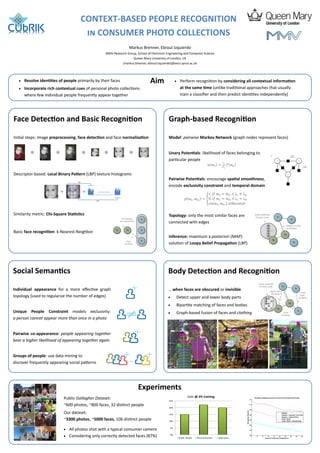CUbRIK research presented at SSMS 2012
- 1. CONTEXT-BASED PEOPLE RECOGNITION in CONSUMER PHOTO COLLECTIONS Markus Brenner, Ebroul Izquierdo MMV Research Group, School of Electronic Engineering and Computer Science Queen Mary University of London, UK {markus.brenner, ebroul.izquierdo}@eecs.qmul.ac.uk ’éĘ Resolve identities of people primarily by their faces Aim ’éĘ Perform recognition by considering all contextual information ’éĘ Incorporate rich contextual cues of personal photo collections at the same time (unlike traditional approaches that usually where few individual people frequently appear together train a classifier and then predict identities independently) Face Detection and Basic Recognition Graph-based Recognition Initial steps: Image preprocessing, face detection and face normalization Model: pairwise Markov Network (graph nodes represent faces) Unary Potentials: likelihood of faces belonging to Face Pairwise potential particular people f1 f2 1 Øæó ØæżØæø = Øæō ØæżØæø ØæŹØæō Unary potential Descriptor-based: Local Binary Pattern (LBP) texture histograms f3 Pairwise Potentials: encourage spatial smoothness, LBP encode exclusivity constraint and temporal domain ŌĆ” for each block ŌĆ” Ø£Å, Øæ¢Øæō Øæż Øæø = Øæż ØæÜ Ōł¦ Øæ¢ Øæø ŌēĀ Øæ¢ ØæÜ LBP ØæØ ØæżØæø, Øæż ØæÜ = 0, Øæ¢Øæō Øæż Øæø = Øæż ØæÜ Ōł¦ Øæ¢ Øæø = Øæ¢ ØæÜ ØæÉØæ£ Øæż Øæø , Øæż ØæÜ , Øæ£ØæĪŌäÄØæÆØæ¤ØæżØæ¢ØæĀØæÆ Similarity metric: Chi-Square Statistics Topology: only the most similar faces are Unary potential of every node Tr All samples Tr Tr are independent connected with edges Based on face similarities Te Te Tr Basic face recognition: k-Nearest-Neighbor Te Inference: maximum a posteriori (MAP) Tr Te Face similarity solution of Loopy Belief Propagation (LBP) Tr Social Semantics Body Detection and Recognition Unary potential of every node Tr Individual appearance for a more effective graph ŌĆ” when faces are obscured or invisible Upper body Tr Lower similarity topology (used to regularize the number of edges) ’éĘ Detect upper and lower body parts body similarity Te ’éĘ Bipartite matching of faces and bodies Te Unique People Constraint models exclusivity: ’éĘ Graph-based fusion of faces and clothing Face Tr similarity a person cannot appear more than once in a photo Pairwise co-appearance: people appearing together bear a higher likelihood of appearing together again Groups of people: use data mining to ... discover frequently appearing social patterns Experiments Gain @ 3% training Public Gallagher Dataset: 25% ~600 photos, ~800 faces, 32 distinct people 20% Our dataset: 15% ~3300 photos, ~5000 faces, 106 distinct people 10% ’éĘ All photos shot with a typical consumer camera 5% ’éĘ Considering only correctly detected faces (87%) 0% + Graph. Model + Social Semantics + Body parts

